#Gee’s Bend: The Women and Their Quilts
Photo


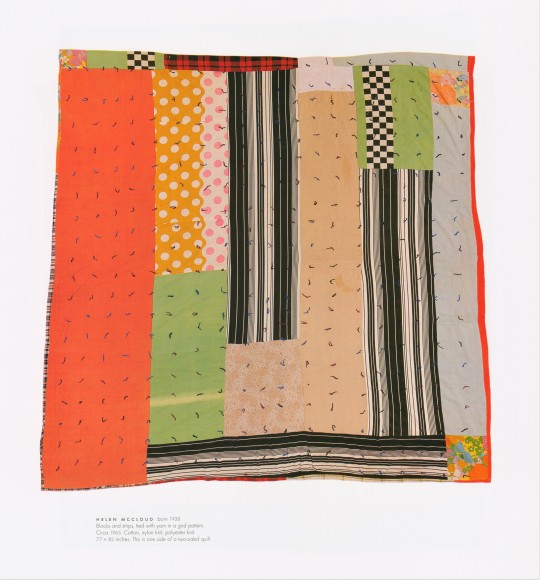
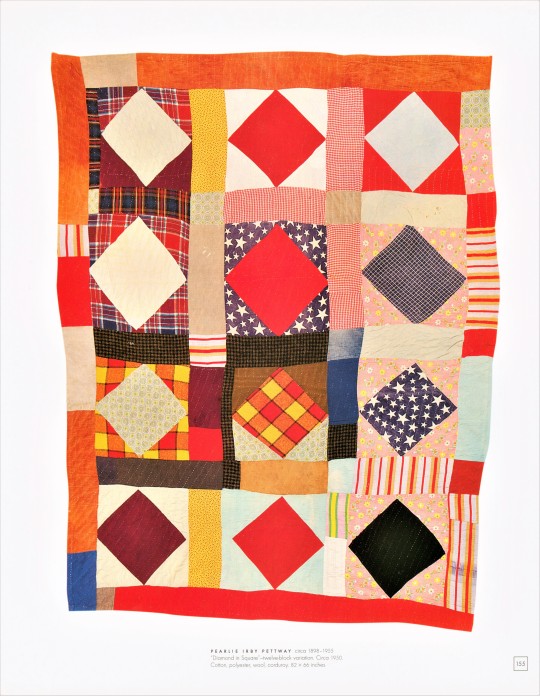
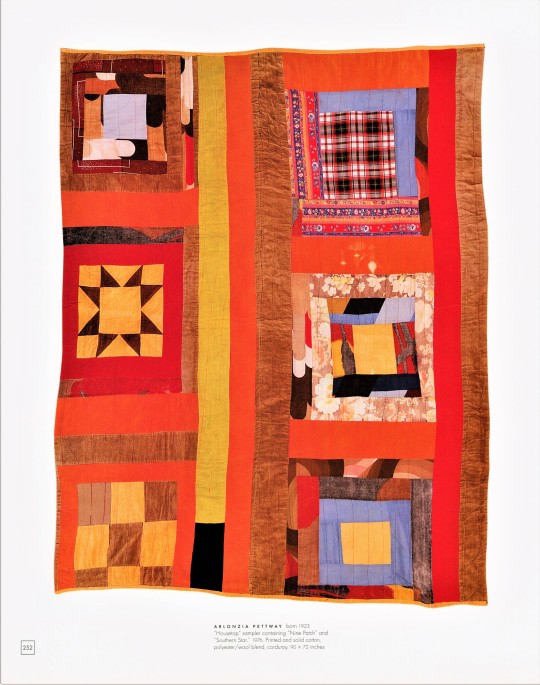



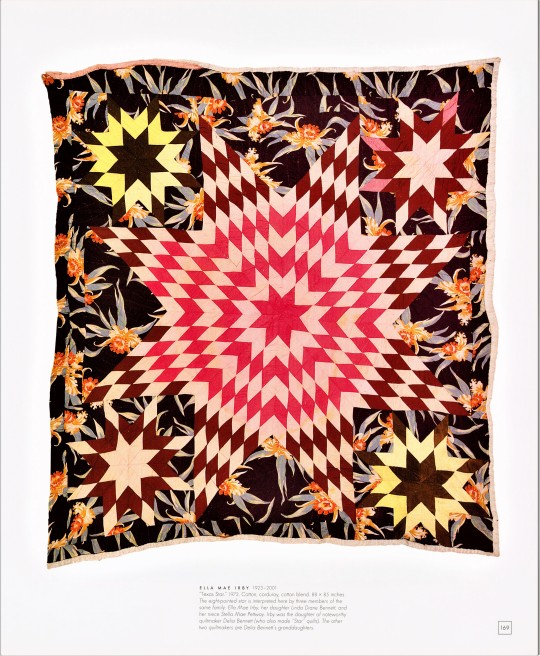
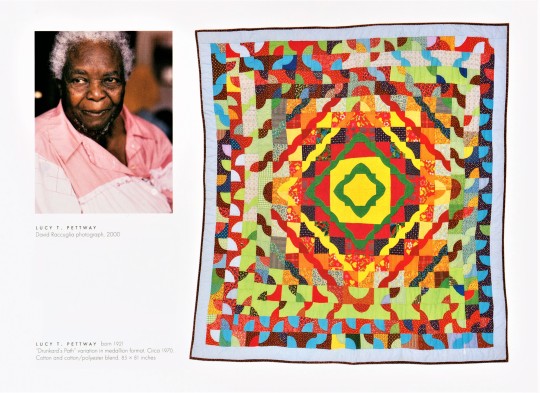
Decorative Sunday
GEE’S BEND QUILTS
Since the 19th century, the women of Gee’s Bend in southern Alabama have created stunning, vibrant quilts. In 2002, folk art collector, historian, and curator William Arnett organized an exhibition entitled "The Quilts of Gee's Bend," which debuted at the Museum of Fine Arts in Houston and later travelled to a dozen other locations across the country, including our own Milwaukee Art Museum (September 27, 2003 - January 4, 2004). This exhibition brought fame to the quilts, and Arnett's foundation Souls Grown Deep Foundation continues to collect and organize exhibitions for Gee’s Bend Quilts.
The images shown here are from Gee’s Bend: The Women and Their Quilts, with essays by John Beardsley, William Arnett, Paul Arnett, and Jane Livingston, an introduction by Alvia Wardlaw, and a foreword by Peter Marzio. The book was published in 2002 by Tinwood Books, Atlanta, and published in conjunction with the 2002 exhibition at the Museum of Fine Arts, Houston. It includes 350 color illustrations and 30 black-and-white illustrations. The dust jacket notes observe:
The women of Gee’s Bend - a small, remote, black community in Alabama - have created hundreds of quilt masterpieces dating from the early twentieth century to the present. . . . [The] quilts carry forward an old and proud tradition of textiles made for home and family. They represent only a part of the rich body of African American quilts. But they are in a league by themselves. Few other places can boast the extent of Gee’s Bends’s artistic achievement, the result of geographical isolation and an unusual degree of cultural continuity. In few places elsewhere have works been found by three and sometimes four generations of women of the same family, or works that bear witness to visual conversations among community quilting groups and lineages.
Our copy is a gift from our friend and benefactor Suzy Ettinger.
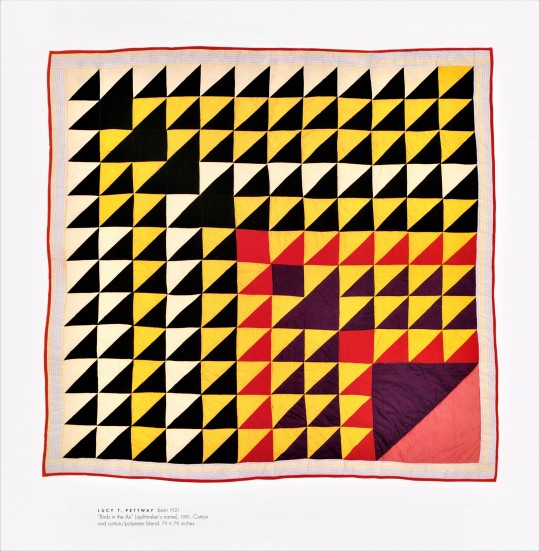
View more Black History Month posts.
View more Decorative Sunday posts.
#Decorative Sunday#Black History Month#decorative plates#decorative arts#quilts#Gee's Bend#quilts of Gee's Bend#Gee’s Bend: The Women and Their Quilts#Museum of Fine Arts in Houston#William Arnett#John Beardsley#Paul Arnett#Jane Livingston#Alvia Wardlaw#Peter Marzio#Tinwood Books#Suzy Ettinger#Black artists#Black women artists
593 notes
·
View notes
Text
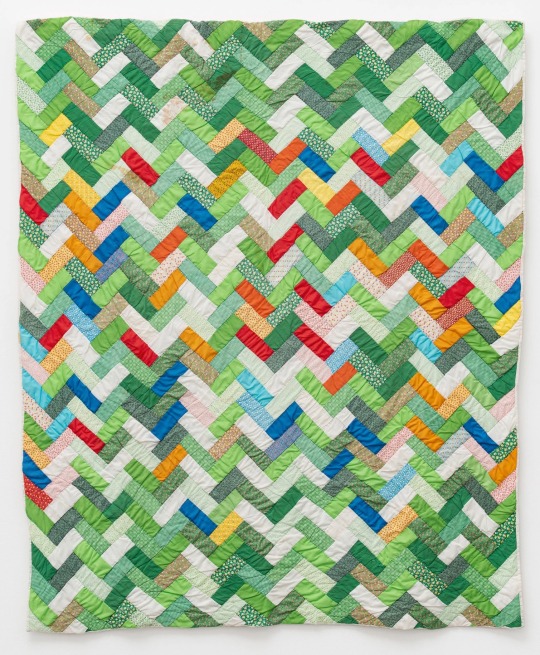
Candis Mosely Pettway
Coat of Many Colors
1970
#quilt#quilting#quiltblr#quilt making#gee’s bend#gees bend#freedom quilting bee#quilting bee#women artists#american art#art history#modern art#aesthetictumblr#tumblrpictures#tumblrpic#african american art#black artists#tumblrstyle#tumblr art#tumblrposts#aesthetic#Candis Mosely Pettway
143 notes
·
View notes
Text
The Quilters of Gee's Bend
To celebrate International Women's Day, but also because I think everyone should know these amazing women artists

Gee's Bend is an isolated, rural community in southwestern Alabama. It is a community originally formed by the emancipated peoples of the cotton plantation of Joseph Gee, on the former plantation lands. They worked the land as cotton sharecroppers until a Depression-era Federal program helped residents acquire the land outright.
Quilting began as a necessity in the 19th century. Women in the community quilted with whatever little scraps of leftover or worn fabric they could procure - patchwork quilting. This led to a style of quilting very different from more regularized patterns; forms were more freeform and dictated by the shape of the fabric at hand. The Gee's Bend patchwork style was passed down through generations of families living in the community; it came to develop it's own artistic "fingerprint" through the isolation of the community.
By the 1960s the economy in the rural area was very bad due to the continuing fall in cotton prices over decades. As a way to supplement community incomes, the local quilters formed the Freedom Quilting Bee, a workers' cooperative that gave them a forum for selling their quilts. The quilts quickly became sought after by collectors, due to their daring abstract patterns, which so seemed to echo and interact with ongoing "high art" stylistic progression of the 20th century. Gee's Bend quilts today are still some of the most sought after and valued.

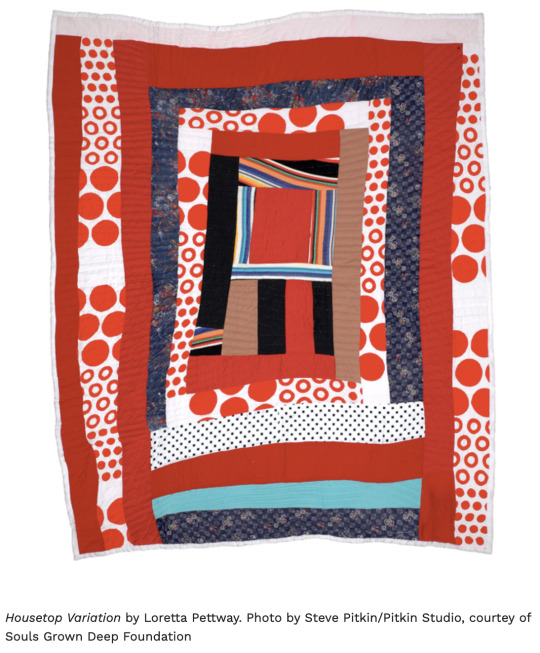


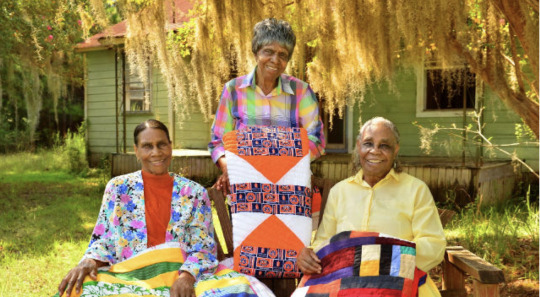
Quilters Loretta Pettway, Lucy Mingo, and Mary Lee Bendolph photographed in 2015 for the NEA National Heritage Award
Please take a look at the Souls Grown Deep Foundation website, where you can learn more about the individual quilters, see more images of their works, and learn more about the community.
72 notes
·
View notes
Text

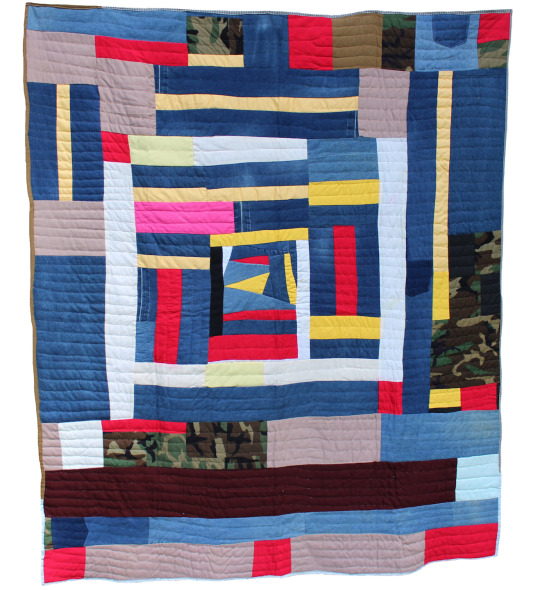


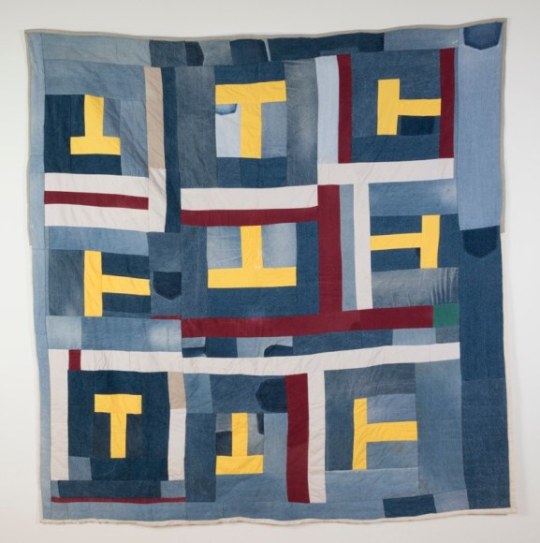

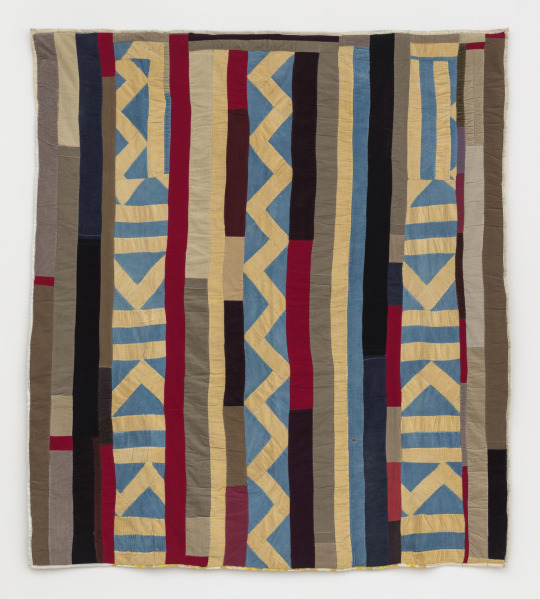
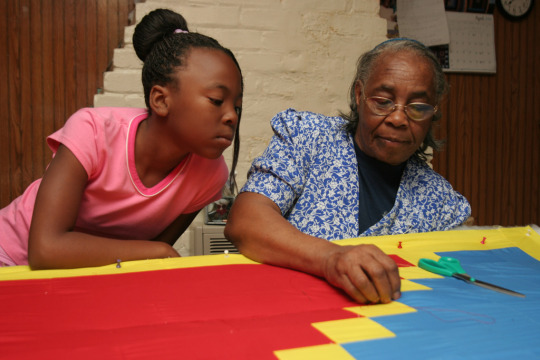


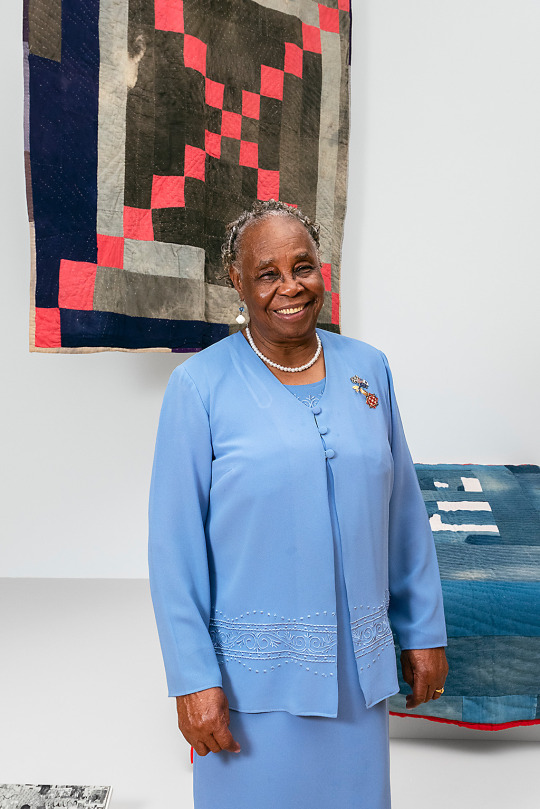
MARY LEE BENDOLPH
(b. 1935, Boykin, AL)
Lives and works in Boykin, Alabama
"Bendolph hails from Gee’s Bend,
Alabama, and she inherited the piecework quilt-making techniques and visual styles that generations of Black women developed and passed down in that hamlet on a peninsula.
Bendolph and other Gee’s Bend quiltmakers’ mastery of abstraction in their work has catapulted what was once a homegrown practice to an internationally acclaimed art form recognized in scholarship, exhibitions, and documentaries. But more often than not, these artists are cast as a collective entity.
Bendolph’s practice, like those of the other Gee’s Bend quiltmakers, was shaped by intergenerational hardships brought on by the legacy of slavery, economic inequality, and intentional isolation on the part of white residents in the nearby community of Camden during the Jim Crow era. Quilts were once a necessary and precious household item that provided
sharecroppers warmth and were thus a means of self-reliance, a result of the community turning inward. But these conditions also facilitated a visual vocabulary and material culture specific to the region. https://nicellebeauchene.com/.../10/MLBendolph_Press-1.pdf
45 notes
·
View notes
Text

A group of women quilting in Gee's Bend, Alabama, USA. From quilt.
4 notes
·
View notes
Text
Embracing Tradition: The Timeless Charm of Patchwork Quilts
In the realm of textile arts, few creations evoke the same sense of nostalgia and warmth as the Patchwork quilt. Born out of necessity and ingenuity, these intricately stitched masterpieces have transcended their utilitarian origins to become cherished heirlooms and symbols of creativity.
Patchwork quilting, dating back centuries, has deep roots in cultures around the world. From the vibrant quilts of Gee's Bend in Alabama to the intricate designs of Amish communities, each patchwork quilt tells a unique story of heritage and craftsmanship.
At its essence, patchwork quilting is a celebration of resourcefulness. Historically, quilters repurposed worn-out clothing and scraps of fabric, ingeniously piecing them together to create functional blankets. What began as a practical solution evolved into an art form, with Queen quilt meticulously selecting fabrics, arranging them in harmonious patterns, and stitching them together with precision.
Beyond their aesthetic appeal, patchwork quilts carry layers of meaning and symbolism. They represent community bonds, as quilting bees provided opportunities for socializing and sharing skills. They also embody resilience, as quilters transformed humble scraps into objects of beauty and utility.
Moreover, patchwork quilts serve as historical artifacts, preserving snippets of the past within their stitches. Each fabric swatch holds a memory—a cherished garment, a beloved tablecloth, or a piece of fabric passed down through generations. As such, quilts become tangible connections to ancestry, offering glimpses into the lives and stories of those who came before.
In contemporary times, the allure of Hummingbird women's clothing patchwork quilting endures. While modern quilters may have access to a plethora of fabrics and tools, the spirit of creativity and resourcefulness remains unchanged. Quilting communities thrive online and in person, where enthusiasts gather to share patterns, techniques, and camaraderie.
In a fast-paced world marked by constant change, patchwork quilts stand as timeless treasures, offering solace and continuity. They remind us of the beauty found in simplicity, the value of tradition, and the power of creativity to transform the ordinary into the extraordinary. As we wrap ourselves in the warmth of a Patchwork quilt, we embrace not only its physical comfort but also the enduring legacy of craftsmanship and love woven into its fabric.
0 notes
Photo
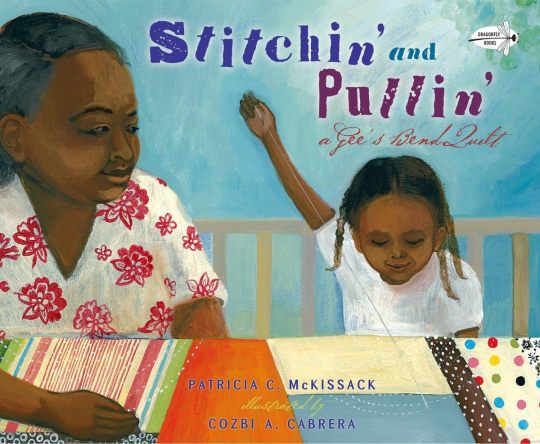
Stitchin’ and Pullin’: A Gee’s Bend Quilt
Author & Illustrator: Patricia McKissack & Cozbi A. Cabrera
Age Range: 5-9
Theme: Community, Art, Heritage
This book captures the rich tradition of quilting in Gee’s Bend, Alabama, and the strong sense of community and history that inspires the women to create beautiful quilts, told through the eyes of a young girl learning from her elders.
Description/Introduction:
Experience the warmth and beauty of Gee’s Bend quilting through the story of a young girl absorbing the art and stories of her ancestors. This tale not only celebrates the vibrant patterns and colors of Gee’s Bend quilts but also honors the deep-rooted community ties and the transmission of knowledge and tradition from one generation to the next.
Quotes/Reviews:
“A beautifully illustrated celebration of tradition, art, and the bond between generations.” - School Library Journal
By delving into the story of Gee’s Bend and its quilts, readers are encouraged to appreciate the significance of cultural heritage and the collective joy of creating something meaningful together.
Content Value
Encourages appreciation for cultural heritage and the beauty of creating something meaningful together as a community.
0 notes
Text
0 notes
Text
Quilting Artists
Annie Mae Young
- Born in Alabama, Annie Mae had been making quilts from a young age, taught by her mother. He tradition of wilt making was passed down through generations of women from the Gee’s Bend. He Gee’s Bend is an area is Alabama that is isolated and inhabited by a community of African Americans who are descendants of the African slaves who were brought to America during the slave trade. This community is known for the quilts they made which are durable and made to a high quality as they had to function properly to ensure the people could stay warm when they lived in cold huts.
- The ‘Quilters of Gee’s Bend are known for making vibrant quilts made from patches of fabric creating geometric patterns that were almost grid like.
- ‘The Quilts of Gee’s Bend’ was an exhibition in 2002 that presented the quilts made by four generations of women from the community. The exhibition had roughly sixty quilts made from 1930-2000.
- The quilts were made using a rage of materials such as cotton, corduroy and denim. These materials were scraps from clothing that were too worn to be used etc and it was a sustainable way for them to recycle their materials and save money as it was quite a deprived community.
Faith Ringgold
- I first saw Faith Ringgold’s works in Paris earlier this year at an exhibition.
- I thought her works were really interesting as she was using the textiles and quilting to tell a story. My favourite piece was ‘Tar Beach #2’ as there’s so much going on that it was both overwhelming and joyful to experience. She creates a narrative through her works, taking inspiration from Buddhist tankas (Tibetan Buddhist painting where the paint is applied directly onto fabric). She uses her pieces to explore social and political issues in her surrounding areas as well as things that bring her joy in life such as her family.

0 notes
Text
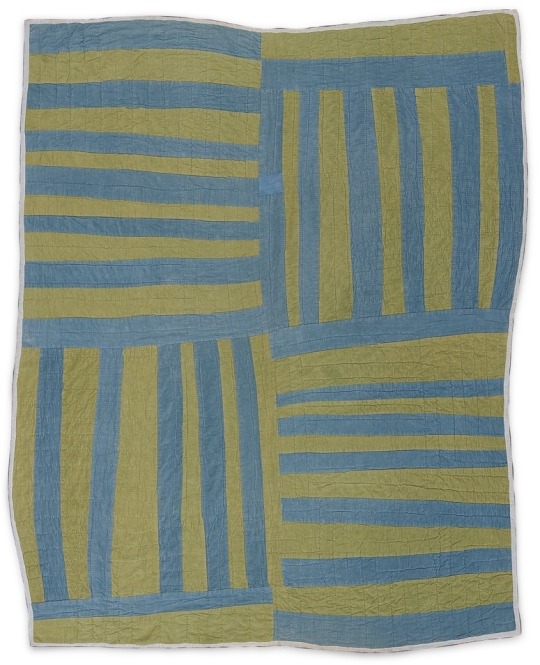
Florine Smith
Four-block strips
c. 1975
#Florine Smith#gee’s bend#quilt#quilting#quiltblr#quilters#quilters of tumblr#black artists#women artists#woman artist#african american art#modern art#american art#art history#aesthetictumblr#tumblraesthetic#tumblrpic#tumblrpictures#tumblr art#aesthetic#textiles#textile art#abstract
92 notes
·
View notes
Text
quilting is so so beautiful and it is literally the most important north american art discipline there is. african american abstract quilting especially has been consistently overlooked even in quilting circles, but quilting as a whole has been pushed aside because of its position as a “women’s art”, when in fact it was probably the most popular and most accessible art form at the time.
the quilters of gee’s bend especially developed such a beautiful abstract quilting style that was leagues ahead of any abstraction happening in modern art circles and developed independently of white western tradition, passed down through generations of black women. quilting in north america is so entwined with the civil rights movement and collective art and liberation, even the fabric itself is imbued with so much meaning and context. this practice of both practicality and abstraction developing so beautifully in such a small and niche community is something that should be celebrated more than it has historically has been. and the deep ties to both african art and native american art should not be overlooked.
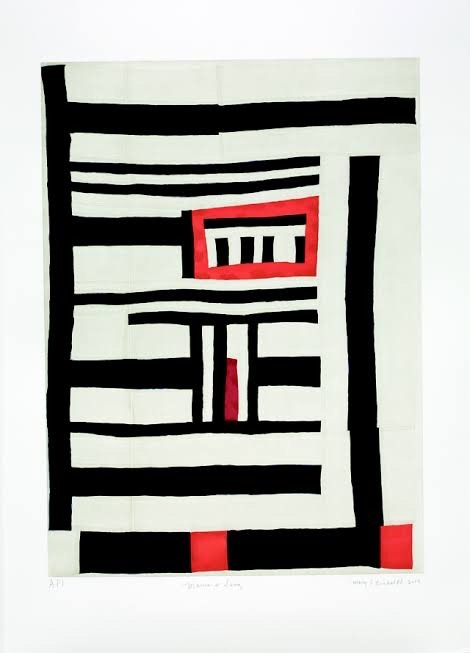

both of these quilts were made by Mary Lee Bendolph
#also obviously not saying that abstraction hasn’t existed before quilting that would be stupid#but this specific blocky and non symmetrical abstraction wasn’t really an established practice before a couple of centuries ago if that
0 notes
Text
"Quilts made by generations of women in Gee’s Bend, Alabama, have hung in the Met, the Whitney, and the Smithsonian Museum of Art. They’ve been shown at galleries and art fairs around the world. But if the quilters want to directly sell their world-famous quilts — vibrant, often asymmetrical, charismatic works, originally hand-stitched for warmth from scavenged fabric — they’ve had to wait for prospective buyers to come to them.
That requires a drive deep into the Alabama Black Belt, along red dirt roads with little to no cell signal, through an isolated stretch of grassy meadows and pine woods, to a community deep in an oxbow of the Alabama River that, if the ferry’s not running, is nearly 40 miles from the closest hotel, supermarket, or pharmacy.
At least, this is how it worked before February of 2021.
Despite their celebrity, much of the quilters’ fame is based on visitors sharing their work outside of their community — and historically, the financial benefits have gone to people outside of their community, too. Occasionally, some of that trickles back in the form of one-off gallery sales, or copyright royalties. But it hasn’t been enough to lift this Black community, renowned in the art world, out of what the United Nations has called some of the most extreme conditions of poverty in the developed world.
One thing the Gee’s Bend quilters have needed is an easier way to sell quilts directly — control what they offer, set the prices, and reap all the profits. So, a year ago this month, three generations of Gee’s Bend quilters launched their own Etsy shops, turning the online platform into the accessible, direct-to-consumer sales opportunity they had been missing.
None of them had ever used Etsy before, but some were certainly familiar with it — and not for the opportunity it offered them. For years, a chorus of independent crafters had been peddling #geesbendinspired quilts on Etsy. While they racked up sales leveraging the Gee’s Bend name, the women behind their key search term carried on quilting when they could acquire fabric.
These days, when fourth-generation quilter Claudia Pettway Charley spots a “Gee’s Bend-inspired” quilt on Etsy, she’ll reach out to the seller to ask them how exactly they are related to her or her community. She hopes to engage them in a thoughtful dialogue about appropriation. She rarely receives a response.
“We put a lot of work into it, and it’s about our life,” Charley says of quilting. She recently took on the job of community manager in Gee’s Bend, vetting partnership opportunities and acting as a liaison between outsiders and her community. “We were struggling. These were made from scraps. Some was old denim that had been worn by my grandfather, torn and faded. My grandmother used corn and feed sacks, washed them and sometimes bleached them to have different colors. It wasn’t ‘I’m just going to go and make this.’ We used these quilts for warmth. It was about our struggle, and our survival.”
Charley might feel differently, she offers, if these makers — who may have, say, studied textiles at art school — sent some of their profits back to the community that inspired them. But that doesn’t happen. “This work is ‘inspired’ in your mind, because you see the quilt pattern,” Charley says. “But you don’t know my story. And you’re going to try and duplicate it — and go to Joann Fabrics to do it?”"
(Article continues at the link)
1 note
·
View note
Photo

There have always been many Americas. Today we reflect on the state of our nation and the complexity of our story—or stories—and we hope for a more unified, peaceful and progressive future. Pictured here, quilts from 'Fabric of a Nation: American Quilt Stories,' made by women across the land over the past 3 centuries. 1. Hoosier Suffrage quilt, before 1920, probably Indiana 2. Double Wedding Ring, about 1940, possibly Missouri 3. Creola Bennett Pettway (American, 1927–2015) or possibly Georgianna Bennett Pettway (American, died in 2012), Bricklayer or Courthouse Steps quilt, about 1955, Gee’s Bend, Alabama 4. @bisabutler (American, b. 1973), To God and Truth, 2019, New Jersey 5. Mrs. Herrick (American, b. 1798), Log Cabin quilt (Barn Raising variation), 1879, Westminster, Massachusetts 6. Album quilt, about 1850, Baltimore, Maryland 7. Carolina Lily quilt, 1830–45, United States 8. Blanket (frazada), mid-19th century, New Mexico Published by @mfapublications @mfaboston Read more about the book via linkinbio. #fabricofanation #quilt #americanquilts #america #suffrage #womenartists #geesbend #americana https://www.instagram.com/p/CnFWYsbJrxr/?igshid=NGJjMDIxMWI=
0 notes
Text
Master Class in Abstract Art: Gee’s Bend Quilts
The National Gallery had an exhibit of art made by Black artists in the South. To me the best ones were the quilts made by women quilters in Gee’s Bend, Alabama, an isolated town on a river. Here they made amazing works of art to sleep under. Some are corduroy (left overs from a Sears project), some are old blue jeans too worn to be worn, all are amazing rhythmic patterns.
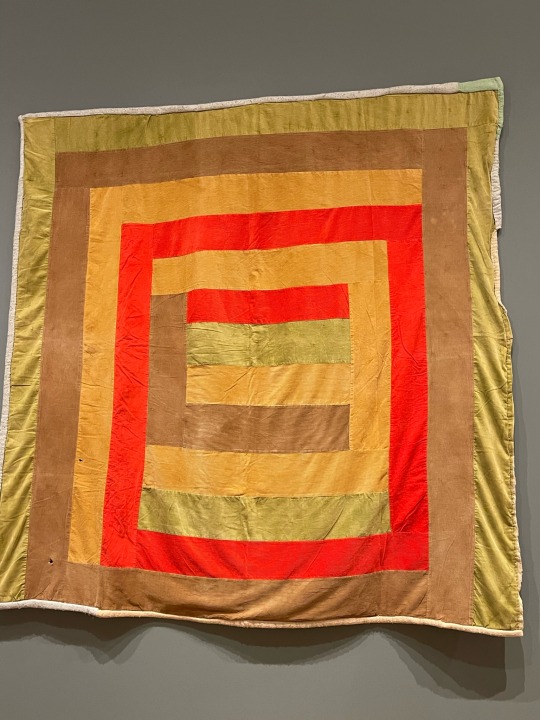




And there was one amazing sculpture about fire which included charred boards

When I came out of the exhibit there was an abstract piece by a famous artist that had gone at this rhythm through a different shape but similar idea to Gee’s Bend quilters

These rhythmic pulses are noticeable everywhere when your eye is tuned. Here’s one I saw after leaving the gallery, bright on dark with amazing “boogie woogie" in the intricate “lacework” of the paint

Look around! Art is everywhere waiting to be enjoyed!
0 notes
Text
BOOK/ARTIST STUDY -HARMONY HAMMOND:
Harmony Hammond - Material Witness - Five Decades of Art The Aldrich Contemporary Art Museum, Gregory R. Miller & co :
“To say that I’m a woman artist; a feminist, a lesbian or queer artist, or even a painter need not be a limitation unless you make it so, nor are they mutually exclusive”. - Harmony Hammond (1)

Quotes & Notes:
This text includes essays and artwork surrounding the work of artist Harmony Hammond. I originally was drawn to this book because of the focus on materiality, found materials, and the artists identity.
Allying abstraction with a social consciousness
practice spans, painting, sculpture, paper works, teaching, activism, curation and writing.
Feminism - process art - biographical experience intersect
“material engagement”
touched - handled abstractions - materiality
primarily additive and accumulative techniques - tying, collaging, layering, wrapping, stitching, braiding, bonded with methods penetrating what she calls “the skin of paint” (7).
Hammond used discarded materials and rescued objects….to imply bodily analogies (8).
strategies of making and mending, the labor of women’s handy-work; in her titanic “installation”
practice is committed to the recuperation and resurgence of a revolutionary women’s history. - 8
“She memorialises an intergenerational and multicultural all-female cast, a heterogeneous daisy chain of creative influencers that range from the weaving, basketry, and beading of indigenous women, the rag rugs of the American pioneers, the quilts of the african-american women of Gees Bend , and the resourceful and inventive craftsmanship of the housewives and inventive craftsmanship of the housewives of the prairies, barrios and middle-class suburbs across the United States ,t…. to such artists-outliers… “(8)
Romaine Brooks, Hilma af Klint, Lee Bontecou, Joan Mitchell, Louise Bourgeois, Louside Neevelson Anges Martin and Eva Hesse” (8).
challenged labels - swaying between various mediums (9).
Politicised perspective - 1970 - feminism - given the intellectual and creative support…which has allowed and helped develop work that comes from my experiences as a woman in this society - 9
“Rags” Girdle - 1971 cloth and acrylic - familiar in the home and studio - 10.
rag - duster, scrap, derived from domestic life, passed down,
“This material was all around her, accessible and plentiful: salvaged matter stroked by female agency; impregnated vestiges of ‘most women’s lives….left overs, hand-me downs, bits of selves, bits of stolen time” (qtd. in 10). Resurrected and reformed.
“most radical works referencing women’s traditional arts” - 10. floor painting - Floorpieces.
made out of commercial knit fabric waste
think of them as paintings
Fray: Art and Textile Politics
Wrapped sculptures
“Body(Like) Materials: Blood and Latex Rubber - 18.
Blood Journals (1994) - mainly incorporates menstrual blood - most fraught and taboo bodily fluid - primary material to make political statements - Hammonds was more” pragmatic” - art materials had not arrived in time - realised she had her “own internal pigment”
Images:

Chenille #9, 2019. Oil and mixed media on gessoed burlap and canvas. 73 x 70 in (185.42 x 177.8 cm) (Above).

Floorpiece II — VI, 1973, Cloth and acrylic, Dimensions variable. (Above).

Bag VI, 1971, Cloth and acrylic, 54 x 22 in (137.16 x 55.88 cm). (Above).

Blood Journals (Giorno I - X), 1994, Mixed media in 10 parts, In 10 parts, each: 15 x 11 in (38.1 x 27.94 cm). (Above).

Lesbian Dreams, 1992. Mixed Media, (Above)

Ledger Drawings Suite B, 2015, Ink on paper in 5 parts, 11.75h x 9.50w in (29.85h x 24.13w cm) - (Above).

Ledger Drawings Suite A, 2015, Ink on paper in 5 parts, 11.75h x 9.50w in (29.85h x 24.13w cm) - (Above).

Girdle, 1971, Cloth and acrylic, 52.25h x 53w in (132.72h x 134.62w cm). (Above).

Floorpiece VI, 1973, Cloth And Acrylic, 65 in diameter (165.10 cm diameter) - (Above).

Flesh Journal #2, 1993, Acrylic On Latex, 11.30h x 8.80w in (28.70h x 22.35w cm) - (Above).

“A pioneering feminist artist, curator, writer, gallery co-founder, activist, and scholar of contemporary lesbian art, Hammond, who is still busy in the studio, at 75, was instrumental in carving out a place for women in the male-dominated contemporary art world of early 1970s New York and beyond” - (TheAldrich).
Links: https://thealdrich.org/news/harmony-hammond-material-witness-five-decades-of-art-the-brooklyn-rail
https://www.alexandergray.com/series-projects/harmony-hammond6?view=slider#6
https://www.getty.edu/research/special_collections/notable/hammond.html
0 notes